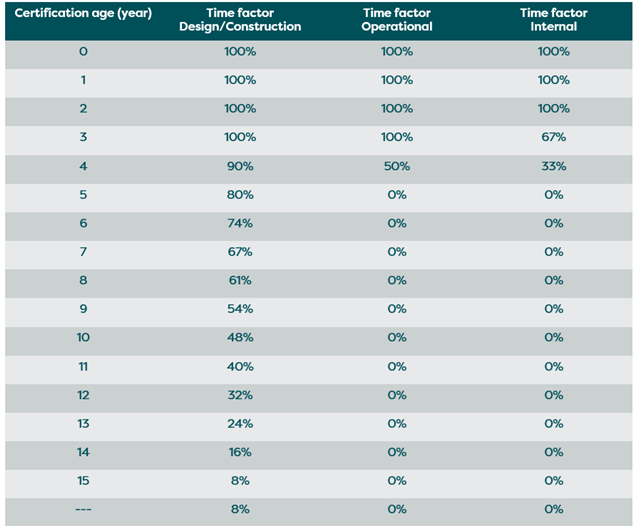Updated summary - GRESB changes for 2024

GRESB have recently published changes to the Real Estate standard and reference guide to take into account for submissions for this year. Our experts at Verco have produced a useful summary guide of the changes to help you remain one step ahead with your reporting.
This article is an update to the summary that we previously published in October 2023 focusing on the pre-release. We have now expanded on this with updates since the pre-release.
Questions where the scoring is affected by the 2024 changes to the submission are in bold italic.
We do not expect any further updates ahead of the submission deadline on 01/07/2024.
Summary
- The value of building certifications in terms of GRESB points will decay over time as in the table below. This could have a significant impact on scoring if certificates are more than 3 years old.
- 15 indicators will be scored differently relative to 2023. These are largely related to the management section, though there are also changes to the way some performance metrics will be scored, and how benchmarks are created which impacts some performance metrics.
- GRESB are beginning the move towards energy efficiency (low energy intensity) scoring. In 2024 a representative score will be provided for energy efficiency, which will be developed and integrated into the scoring in the future.
- Non-operational energy use (electric vehicle charging) can be separated out from operational energy use to ensure that the most appropriate energy use is reported and assets are not penalised for installing EV chargers.
- The total number of points available remains the same.
- Additional information must be collected relating to employee safety to ensure full points are scored for SE4 in 2025.
- No changes have been communicated in relation to the development benchmark.
Summary actions
- Collect information on certification award dates.
- Encourage asset managers to ensure EV chargers are sub metered so that non-operational energy use can be subtracted from total consumption.
- Ensure all employee safety metrics are collected (Workstation and/or workplace checks; Absentee rate; Injury rate; Lost day rate).
- Encourage property managers to ensure their Environmental Management System (EMS) is certified by an external third party to an accepted standard (e.g. ISO 14001).
General changes
Custom peer groups
- Custom peer groups can be selected for 2024 and appear on the benchmark report.
- In 2025, scoring will be calculated based on the custom peer group chosen.
- Restrictions are imposed on what attributes can be selected. This was not the case during the 2023 review period.
Benchmarking methodology
- Country will be included in the benchmarking methodology for scoring indicators where relevant. Previously benchmarking was done at the property sub-type level but it will now be done at the country and property sub-type level where possible.
- This impacts EN1, GH1, WT1, WS1, BC1, BC2.
Property type reclassification
- Medical offices have been moved from “Office” to “Healthcare”
Energy ratings
- Multiple energy ratings can now be submitted against a single asset.
The initial indication from GRESB was that this was only possible for residential assets, but this has been extended to all assets. The GRESB Asset Spreadsheet allows participants to submit up to 5 energy ratings per asset and it is understood that additional energy ratings can be added on the GRESB portal if necessary.
Intensity values
- Assets will now only be included in GRESB’s intensity benchmarks if they have>=75% data coverage, rather than 50% as originally communicated.
Management section
LE2 – ESG objectives
- “General sustainability”; and “Integration into the overall business strategy” have been removed as an option due to overlap with other ESG options available.
- General and issue specific objectives are now weighted more heavily relative to last year meaning the indicator is still worth 1 point.
LE5– Climate-related and DEI senior decision maker
- Fund/portfolio manager option has been removed as an option as it was seen as a duplicate of LE3.
LE6– Personnel ESG performance targets
- Reward for non-financial consequences is now removed meaning all points are awarded for financial consequences for ESG performance.
RP1– ESG reporting
- Points are no longer available for “Section in entity reporting to investors” (previously 1.4 points).
RP2.1– ESG incident monitoring
- Will be worth 0.25 points, previously 0.
- At least 5 stakeholder groups must be informed to score full points.
RM1– Environmental Management System
- Will be worth 1.25 points, previously 1.5 points.
- Points will now only be available if the EMS is aligned with a standard or externally certified.
- If an EMS system is only aligned with a standard rather than certified, it will now score 50% rather than 83%.
RM4– ESG due diligence for new acquisitions
- Will be worth 0.25 points, previously 0.75.
- At least 5 stakeholder groups must be informed to score full points.
RM5– Climate resilience
- Will be worth 0.5 points, previously 0.
- Now includes climate related opportunities, instead of just risks, increasing alignment with TCFD.
Performance section
T1.1– Portfolio improvement targets
- Will be worth 1 point, previously 2.
T1.2– Net Zero targets
- Will be worth 1 point, previously 0.
- Full points achieved by having a net zero target.
EN1 – Energy consumption
- Energy efficiency will be scored in future, but for 2024, will only be calculated and provided separately, similar to custom peer groups in 2023.
- Scoring will be based on energy intensity (kWh/m2).
- Calculated at whole building. Assets that submit landlord and tenant spaces separately will be aggregated to whole building level.
- Only includes assets that were owned standing investments for the full 12 months.
- Only includes assets with >=75% data coverage.
- Only includes assets with vacancy rates <20%.
- Scoring is based on property sub-type and country peer group and the position of the entity within that group.
- Separation of operational and non-operational energy consumption
- With the move to score energy intensity, GRESB are keen to separate out consumption related to operation of the asset from other consumption such as EV charging.
- This appears as though it will need to be done manually on the GRESB portal rather than through the GRESB Asset Spreadsheet.
BC1– Building certifications
- Building certifications may now be submitted if they were awarded after the reporting year so long as they relate to performance of the reporting year and were submitted by the participant during the reporting year. Certifications must be awarded before the submission deadline at the start of July, not before the end of the review period in September.
- Certifications will now be worth fewer points the older they are. Design/construction certifications will always provide some points (8% of total value after 15 years), but operational and interior certificates will decay in value much more rapidly (0% in year 5 for both operational and interior certification).
- The certification year sits alongside the certification type on the GRESB Asset Spreadsheet.

Other minor changes
- Revenue has been removed from the GRESB Asset Level Spreadsheet
Changes for 2025
SE4– Employee safety indicators
- Four metrics will need to be collected to achieve full points:
- Workstation and/or workplace checks
- Absentee rate
- Injury rate
- Lost day rate
- Other metrics (specify)
Custom peer groups
- Scoring for EN1, GH1, WT1, WS1, BC1, and BC2, will be done relative to the custom peer group (if chosen) rather than GRESB’s pre-determined peer group.
